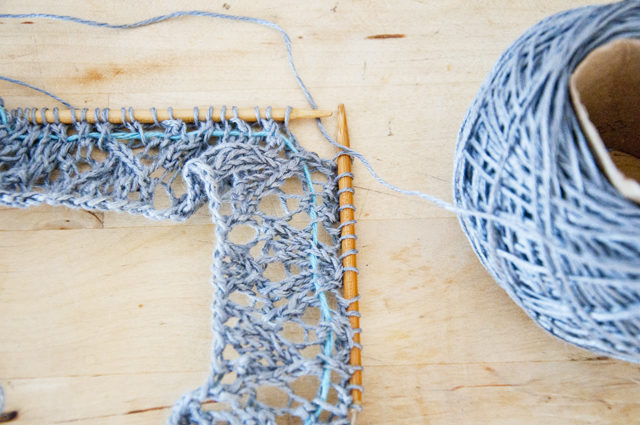Picking up an old work-in-progress sometimes has its challenges if you didn’t leave detailed notes somewhere easy to find! My projects using other designers’ patterns tend to be extremely long term projects that get put on hold for months at a time, so I’ve got a lot of practice trying to work out the mysteries of my WIPs, and the two biggest questions I run up against are wich needles was I using and where was I within the pattern? Here are my tips for solving those mysteries!

Identifying the Needles Used
1. Check Ravelry. I’m not great about entering in my projects when I start them, but sometimes I’m pleasantly surprised to find that I’ve entered my needle details.
2. Check the pattern and what I know about the designer and me. The next thing to look at is the suggested needle size in the pattern. If it’s a familiar designer, I might know that I always have to go down a needle size to match their gauge or that I usually match it. This will also give you a ballpark range of needle sizes to look at.
3. Look for dye stains. My bamboo needles tend to stain when I knit with super saturated colors, so I can sometimes match the stains with the project once I’ve narrowed down a window of sizes to look at. This is my most frequently used method for finding the needles for old WIPs, but it’s not very helpful if you use colored or metal needles.
4. Remember what project the needles were used on next. I generally leave my needles in my WIPs until I have a more urgent project that calls for the same size. If I know what that project is, I can check that notes for it and often have the needle size in there because I update Ravelry after I finish a knit.
5. Knit a new swatch. If all of that fails, I knit a new gauge swatch. It’s a little annoying, but it’s better than having to reknit a whole sleeve or having to rip back because there’s a clear line in the body where the gauge changed.
Note: If you’re picking up a very old WIP and your knitting skills have significantly improved since you started, I recommend knitting a new gauge swatch even if you know what needles you were using before. Many knitters find that their gauge becomes more consistent when they’re more experienced, and that can mean that you now knit at a different gauge with the same yarn and needles because the inconsistencies in your old knitting added up.

Finding the Last Row Knit
1. Check for notes. It never hurts to think the best of your past self! Look at Ravelry for notes. If you annotate patterns, whether that’s print or digital, look to see if you put a note there. I rarely do either, but it’s nice to imagine I might have, so I check.
2. Try to identify which section you’re on. Is it the upper body? The lower body? A sleeve? If you’re using one of my patterns, it should be fairly straight forward to figure out because I generally stick to classic construction methods, but if you’re knitting a pattern that has a unique construction, you may need to study your WIP and compare to the pattern sample photos to figure out what you’ve got in front of you. If you can see that you finished a section before you put your project on hold, this can be enough to tell you where you’re at.
3. Count the stitches on your needle. See what you’ve got on your needle and hope that you weren’t doing a modification that you forgot about. Compare your stitch count for your size to the stitch counts in the section you know you left off on. If there’s shaping, you may be in between the provided stitch counts and will have to do a little math to find the exact row within the shaping section, but you now have enough information to do that. If you know you’re doing a modification, like knitting a larger waist size compared to the rest of the sweater, you’ll need to adjust your counts and and reference both your plans for the modification and the pattern.
4. Read the stitch patterns or colorwork. If your pattern has stitch patterns or colorwork, you may be able to read the last row on your needles and compare it to the chart. If it’s a repeating stitch pattern, you can add up the number of full repeats times the number of rows in a repeat, plus the rows in the partial repeat. That will give you the exact number of rows you worked.

Leave a Reply